Copper is one of the important non-ferrous metals, which is often separated by the flotation process. According to the different oxidation rate of ore, the copper ore can be divided into copper sulfide, copper oxide and mixed copper ore. The copper flotation process used in the various copper ores are also different.
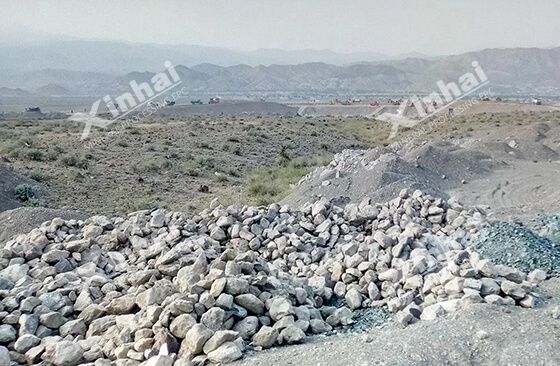
Here is the detailed introduction of copper sulfide flotation process, copper oxide flotation process and mixed copper flotation process, thus to help you reasonably choose the flotation process of copper ore!
Use the table of contents below to navigate through the guide:
01Copper sulfide flotation process
Generally, the copper sulfide mainly includes single copper sulfide and polymetallic copper sulfide, the flotation process of the single copper sulfide is generally simple, and the flotation process of the polymetallic copper sulfide is more complex.
Flotation of single copper sulfide
The mineral composition of single copper sulfide is simple. The copper minerals mainly include chalcopyrite, chalcocite, bornite, covellite and a small amount of copper oxide minerals. The gangue minerals vary with deposit types, mainly including quartz, calcite, feldspar, dolomite, sericite, chlorite and so on. Due to the great difference of floatability between copper minerals and gangue minerals, the flotation process is often used for the separation of single copper sulfide.
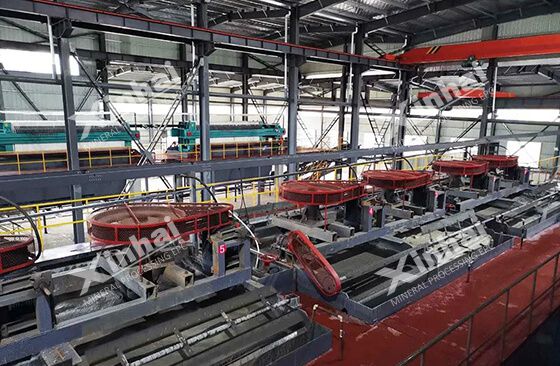
It is worth noting that the structure of the single copper sulfide ore vary greatly due to the different ore occurrence, which makes a difference in monomer separation of copper minerals and gangue monomers. Therefore, the grinding fineness becomes the key factor affecting the flotation index of the single copper sulfide ore. Generally, the flotation process of single copper sulfide mainly has the following three kinds:
◆One stage grinding-flotation process
This copper flotation process is suitable for treating the ore with coarse uniform disseminated grain size. The combination between copper minerals and gangue is loose, and the contact edge is smooth and flat.
When the raw ore is grinded to -200 mesh accounting for 50-60%, the copper minerals can be basically monomer dissociated. The good flotation indexes can be obtained after roughing and scavenging, one to three times of concentrating. This copper flotation process is featured with simple flow and low cost, which is mostly used in small and medium-sized copper concentrators.
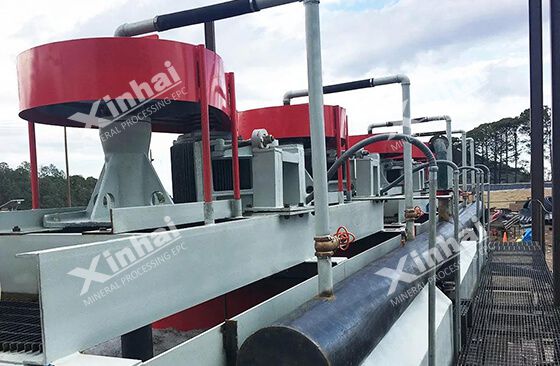
◆One stage grinding-flotation-coarse concentrate regrinding process
This copper flotation process is mostly suitable for treating the single sulfide ore of porphyry copper or copper-molybdenum ore.
According to the distribution of copper minerals, the raw ore is grinded to -200 mesh accounting for 40-70% by the one stage grinding, and a large number of tailings are thrown away by roughing and scavenging. After the regrinding of coarse concentrate, the copper concentrate can be obtained through two to three times of concentrating. The tailings of one time of concentrating in the flotation cycle can be discarded after scavenging or return to the roughing cycle after concentration. A few copper concentrators will regrind the middlings separately and then process them. This copper flotation process can make the copper concentrator get a better economic benefit when the raw ore grade is low and the processing capacity is large. In addition, because the regrinding of the coarse concentrate and fin particle size, the monomer dissociation degree between copper minerals and gangue minerals, pyrite is better, and the flotation concentrate quality is also higher.
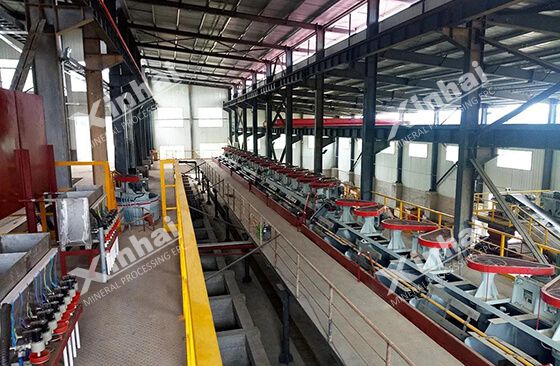
◆Two stage grinding-two stage (or one stage) flotation process
For the uneven distribution of copper ore, the ore needs to be ground to -200 mesh accounting for 80%, or even more fine in order to achieve the monomer separation of most copper monomer. At this point, two stage grinding is superior to one stage grinding both in grinding efficiency and in preventing overcrushing of copper minerals.
When two stage grinding-two stage flotation is adopted, a part of coarse-grained copper minerals can be floated after the first stage of rough grinding. This part of the concentrate grade is generally high and can be directly as a concentrate, or into the last concentrating, or into the concentrating with the floatation concentrate obtained by two stage grinding. The two stage grinding-single flotation process can be adopted if there are less coarse-grained copper minerals in the ore. The flotation cycle adopts scavenging and two or three times of concentrating, the middlings generally return to the second stage grinding cycle. Relatively speaking, this copper flotation process has high grinding cost, complex equipment configuration and production operation, and is mostly used in large and medium-sized copper concentrators.
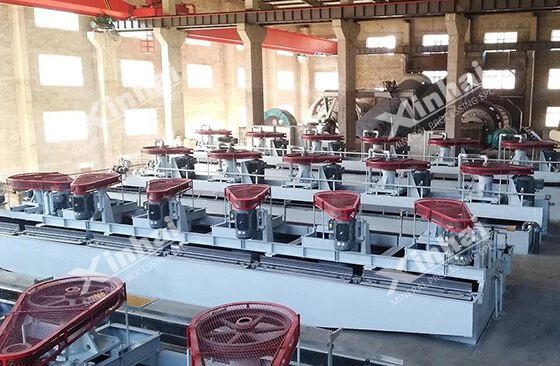
Flotation of polymetallic copper sulfide
In general, the polymetallic copper sulfide not only contains a variety of copper minerals, but also often associated with pyrite, galena, sphalerite and other minerals, the mineral structure levels and composition is more complex, and the symbiotic relationship among minerals is dense. Based on the above ore characteristics, the flotation processes of polymetallic copper sulfide mainly include the following categories:
◆Multi-stage flotation process
This copper flotation process is mainly used to process the copper sulfide minerals containing iron sulfide, its composition is relatively simple, so the multi-stage flotation process is a conventional flotation process for copper sulfide. The key point is the separation of copper and sulfur. Generally, the closed-circuit flotation process composed of multi-stage roughing-multi-stage concentrating-scavenging can achieve a good recovery effect. But this copper flotation process is not suitable to the copper sulfide ore with complex composition.
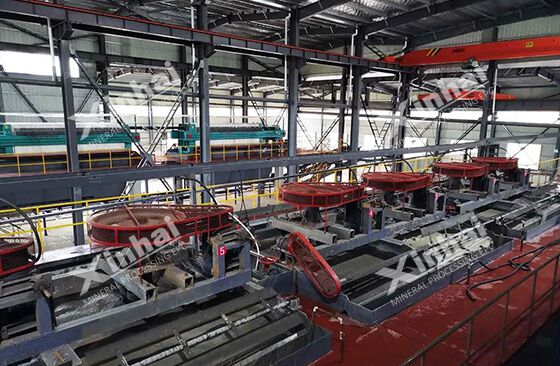
◆Staged preferential flotation
Staged preferential flotation is suitable for the complex copper sulfide ores, whose copper ore types are complex, mainly azurite and arsenite. Although the focus is still on the separation of copper and sulfur, the conventional flotation processes cannot produce the qualified copper concentrates due to their complex structure.
Because of the different floating speed of various copper ores, those easy-to-float copper minerals can be first roughly separated, and then those difficult-to-float copper minerals can be reground and the middlings can be re-separated. Finally, the obtained copper concentrate can be recovered together, so that the grade and recovery rate are guaranteed.
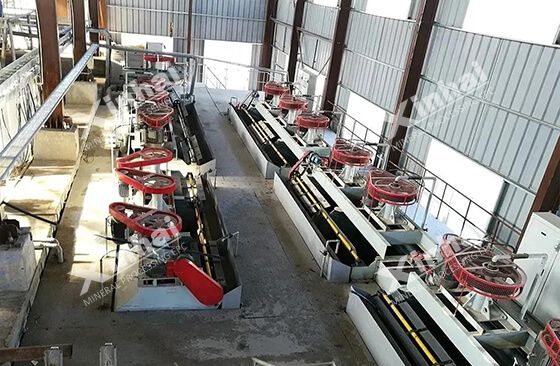
◆Flotation-mixed concentrate separation process
This copper flotation process is mainly applied to the copper sulfide with low grade and has a complex symbiotic relationship with chalcopyrite, sphalerite and galena. A large number of gangue minerals are discharged by coarse grinding and coarse separation, so that the copper-lead-zinc mixed concentrate is obtained. After the separation of copper-lead-zinc mixed concentrate, the single copper mineral is obtained. This flotation process can recover the copper, lead and zinc minerals respectively, but it is easy to cause the incomplete separation of mixed concentrate.
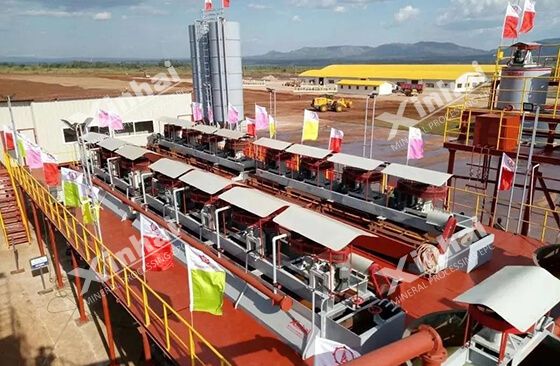
◆iso-flotation process
The copper flotation process float respectively those minerals with fast floatation speed and those minerals with low floatation speed according to the floatation speed of copper and other metal minerals, which can eliminate the influence of residual flotation reagents on the flotation separation, reduce the reagent dosage. But the flotation process is relatively complex, which needs more grinding equipment.
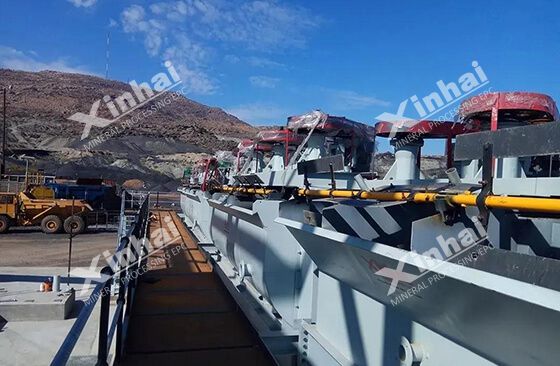
02Copper oxide flotation process
Flotation process is the main separation method of modern copper oxide ore. According to the different properties of copper oxide ore, the copper oxide flotation process can be divided into direct flotation process and sulfide flotation process.
Direct flotation process of copper oxide
The direct flotation processes of copper oxide mainly include the fatty acid flotation process, amine collector flotation process, chelant-neutral oil flotation process and emulsion flotation process, which are often used for the copper oxide ores with simple structure and single properties.
◆Fatty acid flotation process
Fatty acid flotation process uses the fatty acids and their soaps as collectors, and the gangue inhibitor (sodium silicate, phosphate) and pulp regulator (sodium carbonate) are also added in the flotation process. The fatty acids and soap collectors can float the malachite and azurite greatly. When adopting the fatty acids with different hydrocarbon chains to float the malachite, the collecting ability is very strong as long as the hydrocarbon chain is long enough.
The fatty acid flotation process is mostly used for the copper oxide whose gangue doesn’t belong to carbonic acid salts. If the gangue contains a lot of iron, manganese, the flotation index will get worse, and the ore slime will also lead to the failure of fatty acids.
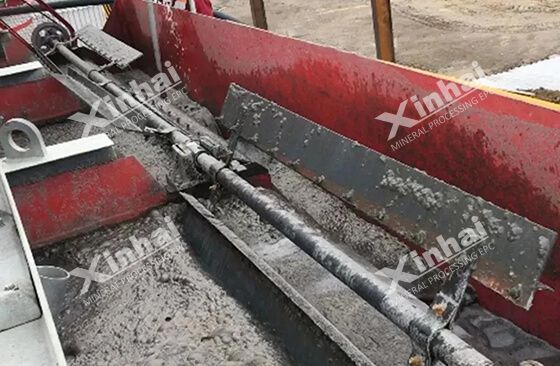
◆Amine collector flotation process
Amine flotation process, also known as cationic collector flotation process, is a common flotation method of nonferrous metal oxide ore (copper, lead, zinc). It uses the amines as collector for flotation, widely used in copper malachite, azurite and chloropyrite.
The amine collector is selective to the copper oxide. Because the amines also have a collection effect on many gangues, it is necessary to finish pre-desliming before separation. But for the argillaceous copper oxide, the pre-desliming will lead to the copper loss. Therefore, the premise of selecting the amine flotation process is the selection and control of gangue inhibitors. At present, the common gangue inhibitors include seaweed meal, lignosulfonates (or cellulose lignosulfonates) and polyacrylic acid.
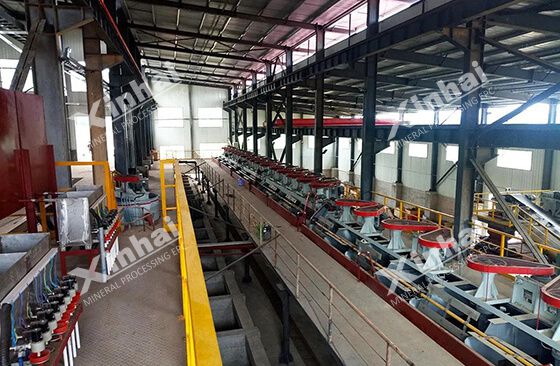
◆Chelant-neutral oil flotation process
This method uses some kind of chelating agent and neutral oil as the collector to complete the flotation process, which is mostly used for refractory copper oxide (such as malachite). It not only has a good selectivity and collecting effect, but also can ensure a higher flotation index, reduce the reagents consumption. Besides, the chelating agent also has a selective inhibition effect.
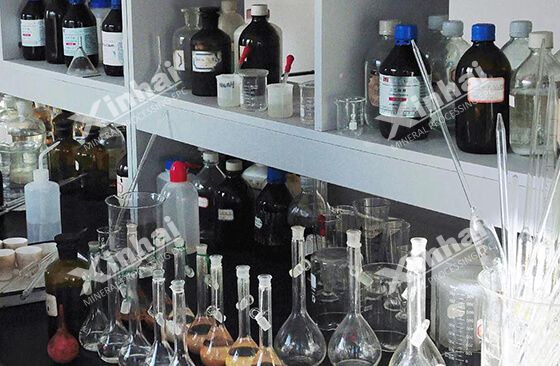
◆Emulsion flotation process
This flotation method is mainly to vulcanize the copper oxide minerals first, and then add copper complexing agent to create a stable surface of lipophile minerals, then cover the mineral surface with neutral oil emulsion to create a strong hydrophobic floating state, so that the minerals can be firmly attached to the froth, thus completing the separation.
Sulfide flotation process of copper oxide
There are two main sulfide flotation processes of copper oxide: conventional sulfide flotation process and hydrothermal sulfide flotation process.
◆Conventional sulfide flotation process
This flotation process vulcanizes the copper oxide minerals firstly (using sodium sulfide or other vulcanizing agents) and adopts the high-grade xanthate type collector to float. In the vulcanization operation, the lower the pulp pH value, the faster the vulcanization operation, and the vulcanizing agent (such as sodium sulfide) is easier to be vulcanized.
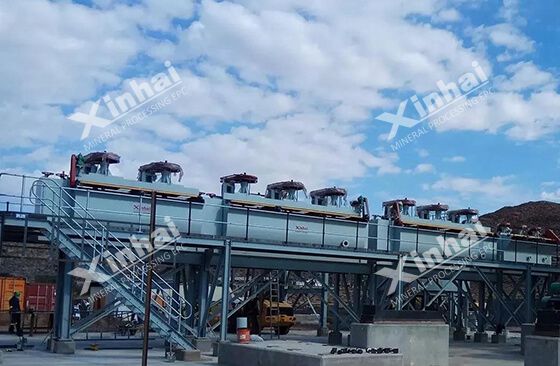
The sulfide flotation process is mainly used to treat the copper oxide minerals (such as malachite, azurite) or zigueline. It is important to note that the silicon malachite needs special treatment first, otherwise the sulfurization effect is not good, or the silicon malachite even cannot be sulfurized.
◆Hydrothermal sulfide flotation process
This flotation process is an extension of the conventional sulfide flotation process. The sulfidation is completed under the condition of hot pressing, the sulfur has the chemical reaction with copper oxide under the condition of hot pressing, thus to obtain a stable and graded artificial copper sulfide minerals, and the copper is recycled in the warm water by the mean of copper sulfide flotation. This method strengthens the pretreatment-pre- sulfidation process of ore, but has the high temperature requirement, large fuel consumption and long sulfidation time.
03Mixed copper flotation process
The sulphide flotation process is generally adopted in the mixed copper ore beneficiation, which mainly has two kinds: first, separate the copper sulfide minerals first, and then separate the copper oxide minerals after the tailings sulfidation. Second, float the copper oxide and copper sulfide at the same time after the sulphidation.
The selection of specific flotation process should be based on the mineral processing test report and concentrator situation. The technological conditions of simultaneous flotation of copper oxide and copper sulfide are basically the same as that of copper oxide, but the amount of sodium sulfide and collector should be reduced with the reduction of copper oxide content in the ore. In this way, the copper sulfide minerals can float well when floating the copper sulfide after the sulfidation.
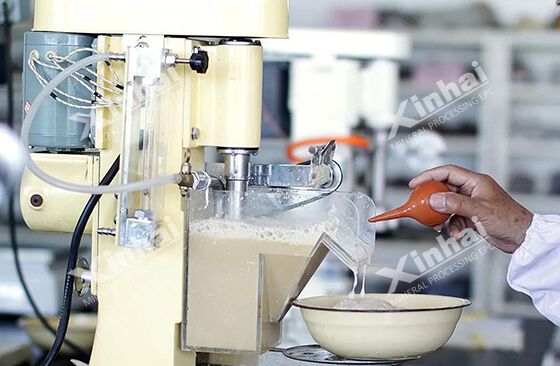
These are the common copper flotation process. For the copper flotation beneficiation, the different copper types adopt the different flotation processes and flotation reagents. It is suggested to carry on the mineral processing test, understand the properties and characteristics of the ore, and the consider the investment budget and the actual conditions of the concentrator, then customize the appropriate flotation process flow and reagents system, so as to obtain the ideal flotation index and economic benefits.


 marketing@ytxinhai.com
marketing@ytxinhai.com  0086 13810327080
0086 13810327080 






































































































 CHAT
CHAT MESSAGE
MESSAGE
















